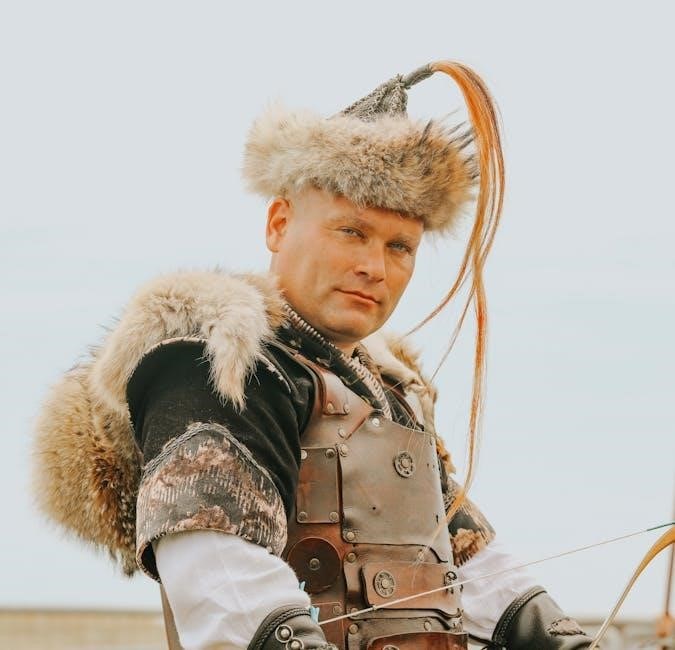The Fighter is a versatile and iconic D&D 5e class, excelling in combat versatility and adaptability. Perfect for newcomers, it offers simplicity while allowing deep customization through feats and subclasses.
Overview of the Fighter Class
The Fighter is a cornerstone of any D&D 5e party, embodying mastery of martial combat. With exceptional versatility, Fighters excel in both dealing damage and withstanding it, making them invaluable on the battlefield. They are highly customizable, offering a wide range of playstyles through Fighting Styles and subclasses. Fighters’ key features include Second Wind, Action Surge, and Extra Attack, providing both durability and offensive prowess. Their ability to use any weapon or armor, combined with frequent ability score improvements, ensures they remain effective at all levels. Whether as a novice’s first character or a veteran’s complex build, the Fighter’s adaptability and reliability make them a timeless choice in the world of Dungeons & Dragons.
Why Play a Fighter in D&D 5e?
Playing a Fighter in D&D 5e offers unparalleled versatility and accessibility. Ideal for both new and experienced players, the class provides a straightforward yet customizable experience. Fighters are adept at both offense and defense, with features like Second Wind and Action Surge enhancing their combat effectiveness. Their ability to wield any weapon and wear any armor allows for diverse playstyles, from archers to tanky defenders. Additionally, Fighters gain more feats than any other class, enabling extensive customization. This adaptability makes them suitable for any campaign, whether focusing on brute strength, tactical prowess, or even blending martial skills with magic. Fighters are perfect for those who enjoy a flexible, dynamic character that can evolve with their playstyle and the story’s demands.
Strengths and Weaknesses of Fighters
Fighters excel as versatile combatants, boasting high hit points, proficiency with all weapons and armor, and features like Extra Attack for devastating offense. Their Action Surge ability grants flexibility in critical moments, while Second Wind enhances survivability. Fighters also shine as tanks, with strong AC and durability. However, they lack the utility of spellcasting classes and rely heavily on feats for customization. At higher levels, their effectiveness may wane compared to casters, though their consistent damage output remains formidable. Despite this, fighters are adaptable to any playstyle, making them a reliable choice for both newcomers and veterans seeking a straightforward yet powerful character.

Core Fighter Class Features
Fighters excel with their resilience, combat versatility, and unique abilities like Second Wind and Action Surge, making them formidable in both offense and defense.
Hit Points and Hit Dice
Fighters in D&D 5e possess robust health, using a d10 Hit Die, which grants them 10 + Constitution modifier hit points at level 1. As they advance, each level adds another d10 or 6 HP, ensuring durability in combat. This high hit point pool, combined with access to heavy armor and shields, makes Fighters some of the toughest frontline defenders. Their ability to recover with Second Wind further enhances their survivability, allowing them to regain hit points once per short rest. This resilience makes Fighters excellent tanks, capable of absorbing significant damage while maintaining offensive pressure.

Proficiencies: Armor, Weapons, and Tools
Fighters in D&D 5e are highly proficient in both armor and weapons, making them versatile combatants. They gain expertise in all types of armor, including heavy armor, and are skilled with simple and martial weapons. This broad proficiency allows Fighters to adapt to various playstyles, whether focusing on melee, ranged, or defensive strategies. However, they lack proficiency in tools, which limits their non-combat utility. This focus on combat tools ensures Fighters remain formidable in battle, exceling in their role as martial experts. Their extensive weapon and armor options make them highly customizable, enabling players to craft unique builds tailored to specific tactics or character backgrounds.
Key Abilities: Strength, Constitution, and Dexterity
Fighters rely heavily on three core abilities: Strength, Constitution, and Dexterity. Strength is crucial for melee attacks and dealing heavy damage with weapons, making it a primary focus for most builds. Constitution boosts hit points and endurance, ensuring Fighters can withstand prolonged combat. Dexterity enhances Armor Class (AC) and is vital for ranged attacks and mobility. While some builds may prioritize one ability over others, a balanced approach ensures versatility. For example, a high Strength supports powerful melee attacks, while high Dexterity improves ranged accuracy and defensive capabilities. Constitution is always important for survival, especially in tough encounters. Optimizing these abilities is key to creating an effective Fighter, whether focusing on offense, defense, or a hybrid playstyle.
Second Wind and Action Surge
Second Wind and Action Surge are cornerstone abilities for Fighters, offering both survival and versatility. Second Wind allows a Fighter to regain hit points once per short rest, providing a reliable way to recover during combat. This ability is particularly valuable for maintaining stamina in prolonged fights. Action Surge, gained at level 2, grants an extra action, enabling Fighters to make additional attacks, cast spells, or perform other critical actions. This feature enhances flexibility and combat effectiveness, making it a key tool for controlling the battlefield. Together, these abilities highlight the Fighter’s adaptability, balancing defense and offense seamlessly. They are essential for both new and experienced players, ensuring the Fighter remains formidable in any scenario.
Extra Attack and Combat Versatility
Extra Attack is a defining feature of the Fighter class, enabling multiple attacks per turn. Starting at level 5, Fighters can make a second attack, increasing to three at level 11 and four at level 20. This ability makes Fighters formidable in both melee and ranged combat, outpacing other classes in sheer attack volume. Combat versatility is further enhanced by Fighting Styles, allowing customization through archery, two-weapon fighting, or dueling. This combination of Extra Attack and adaptable styles ensures Fighters can excel in various playstyles, whether focused on precision, defense, or raw damage output. These features cement the Fighter’s role as a dynamic and powerful martial combatant.

Fighting Styles and Subclasses
Fighting Styles like Archery or Dueling offer specialized combat techniques, while subclasses such as Battle Master, Rune Knight, and Echo Knight provide unique abilities, enhancing customization and versatility for players.
Overview of Fighting Styles
Fighting styles in D&D 5e offer a variety of combat techniques. From Archery to Defense, Dueling, and Two-Weapon Fighting, these styles provide unique bonuses, allowing fighters to tailor their combat approach. Archery enhances ranged attacks, while Defense boosts AC. Dueling and Two-Weapon Fighting improve melee efficiency. These styles are chosen at level 1 or 2, shaping the fighter’s identity. Each style adds depth, enabling fighters to excel in specific roles, whether dealing damage or protecting allies. This customization ensures fighters remain versatile and formidable, adapting to any combat scenario. The choice of style reflects the character’s background and playstyle, making each fighter distinct and effective.
Top Fighter Subclasses: Battle Master, Rune Knight, and Echo Knight

The Battle Master, Rune Knight, and Echo Knight are standout Fighter subclasses in D&D 5e, each offering unique combat enhancements. The Battle Master excels in tactical combat, using maneuvers like Trip Attack and Precision Attack to control the battlefield. The Rune Knight taps into ancient magic, carving runes into weapons for devastating effects and gaining resistance to damage types. The Echo Knight manipulates time and space, creating echoes that attack and confuse enemies, while also gaining resistance to force damage. These subclasses provide distinct playstyles, from strategic mastery to magical and temporal manipulation, making them top choices for players seeking versatility and power in their Fighter builds.
Other Notable Subclasses and Their Features
Beyond the top subclasses, Fighters have access to other unique options. The Champion, for instance, focuses on resilience and critical hits, making them durable frontline warriors. The Samurai subclass combines martial prowess with honor and intimidate mechanics, inspiring allies while intimidating foes. The Cavalier excels in mounted combat and protecting allies, using their aura to shield companions. Lastly, the Eldritch Knight blends martial and arcane abilities, casting spells and using weapon attacks in tandem. Each subclass offers distinct playstyles, allowing Fighters to adapt to various roles and strategies, ensuring there’s a Fighter build for every concept and campaign need.

Ability Scores and Race Selection
Fighters thrive with high Strength, Constitution, or Dexterity, depending on their build. Races like Half-Orc or Dragonborn complement these abilities, enhancing resilience and combat effectiveness.
Optimizing Ability Scores for Fighters
For a Fighter, prioritizing Strength, Constitution, and Dexterity is crucial. Strength enhances melee damage, Constitution boosts hit points, and Dexterity improves AC and ranged attacks. At level 4, 8, 12, 16, and 19, ability score improvements allow further optimization. Allocating points to a primary fighting style, whether archery or melee, ensures maximum effectiveness. For example, a Strength-based Fighter might focus on Strength and Constitution for tanking, while a Dexterity-based Fighter would emphasize Dexterity and Constitution for agility. Balancing these scores ensures versatility in combat, making the Fighter adaptable to various playstyles and encounters. This optimization ensures the Fighter remains a formidable presence on the battlefield.
Best Races for Fighter Builds
Choosing the right race for your Fighter can significantly enhance their abilities. Humans are a top choice due to their versatility and extra feat at level 1. Half-Orcs excel with their Strength bonus and Relentless Endurance, making them ideal for tanky or high-damage builds. Dragonborn, with their Strength and Charisma bonuses, are great for front-line fighters. Goliaths, thanks to their Mountain Born trait, provide excellent Constitution boosts, perfect for survivability. Dwarves, especially with their Dwarven Combat Training, are excellent for defensive or weapon-focused fighters. Each race offers unique traits that complement the Fighter’s class features, allowing for tailored builds that match your desired playstyle. Race selection is a key step in optimizing your Fighter’s effectiveness in combat.

Skills, Feats, and Backgrounds
Fighters excel through strategic skill selections, feats for customization, and backgrounds that add depth. Skills like Athletics and Perception enhance versatility, while feats and backgrounds tailor your character’s identity and combat style.
Choosing the Right Skills for Your Fighter
Selecting the right skills for your Fighter is crucial for maximizing their effectiveness in both combat and roleplay. Fighters gain proficiency in two skills of their choice, allowing them to excel in areas beyond martial prowess. For a more versatile build, consider skills like Athletics for physical tasks, Perception to stay alert, and Intimidation to dominate social interactions. If your Fighter emphasizes stealth, Stealth and Sleight of Hand can be invaluable. Additionally, Survival and Nature are excellent for outdoor adventurers. Each skill choice should align with your character’s background and playstyle, ensuring they are well-rounded and capable in various scenarios. This customization allows Fighters to shine in both combat and non-combat situations, making them a versatile asset to any party.
Feats for Fighters: Maximum Customization
Feats are a cornerstone of Fighter customization in D&D 5e, offering unparalleled flexibility. With more feat options than any other class, Fighters can tailor their abilities to suit any playstyle. Feats like Sharpshooter enhance ranged combat, while Great Weapon Master boosts melee prowess. War Caster and Tough improve survivability, making Fighters more durable in battle. Many feats also complement Fighting Styles, allowing for synergies that amplify combat effectiveness. Fighters can choose feats at levels 4, 8, 12, 16, and 19, providing consistent power growth. This system ensures Fighters remain adaptable and powerful, capable of excelling in any role. Feats are the key to crafting a unique Fighter, making them a standout class for customization enthusiasts.
Backgrounds That Complement Fighter Builds
Choosing the right background enhances a Fighter’s identity and capabilities. The Athlete background is ideal for agile Fighters, granting expertise in Acrobatics and Athletics. Soldier provides combat-related skills and insights, fitting for seasoned warriors. For a more charismatic Fighter, Noble offers proficiency in History and Persuasion. Outlander suits rugged, survival-oriented Fighters, while Entertainer adds flair with performance skills. Each background adds unique flavor, allowing Fighters to excel both in and out of combat. By aligning background skills with ability scores, Fighters can create well-rounded characters tailored to their playstyle. Backgrounds provide depth and utility, making them a crucial part of any Fighter build.

Advanced Tactics and Multiclassing
Fighters excel in battle strategy and positioning, leveraging their combat versatility. Multiclassing allows blending martial prowess with magical or stealth abilities, enhancing adaptability in diverse adventuring scenarios;
Mastering Combat Tactics as a Fighter
Fighters excel in combat through strategic positioning and ability usage. Using Second Wind to recover HP and Action Surge for extra attacks can turn the tide of battle. They shine in controlling the battlefield, whether through archery, dueling, or two-weapon fighting styles. Fighters’ Extra Attack feature allows multiple strikes, making them formidable damage dealers. Their Indomitable trait grants resilience by rerolling failed saves. Proficiency in armor and weapons ensures versatility, while feats enhance specific skills. By mastering these tactics, fighters become indispensable assets, balancing offense and defense seamlessly.
When and How to Multiclass with Fighter

Multiclassing with Fighter can enhance versatility, blending martial prowess with other classes’ unique abilities. Pairing Fighter with Rogue adds sneak attack damage, while combining it with Wizard introduces spellcasting. Fighters’ feats and Extra Attack complement classes like Barbarian or Paladin, boosting damage and survivability. Multiclassing is ideal for creating hybrid builds, like a Battle Master Rogue or Eldritch Knight Fighter. However, timing is crucial; taking Fighter levels early maximizes proficiencies and combat features. Always align multiclass choices with your character’s narrative and playstyle to ensure a cohesive and powerful build.

Example Builds and Optimization Tips
Explore sample Fighter builds like the Battle Master or Champion, optimizing for damage, tanking, or versatility. Tailor race, feats, and subclass choices to your playstyle for maximum impact.
Sample Fighter Builds for Different Playstyles
Discover diverse Fighter builds tailored to specific playstyles. The Battle Master excels at tactical combat, using maneuvers for crowd control. The Champion focuses on stamina and resilience, making them ideal tanks. For ranged combat, the Archery Fighter maximizes Dexterity, delivering precise, high-damage attacks. The Rune Knight combines martial prowess with magical runes, offering versatility. Each build highlights unique subclass features, ability score priorities, and feat selections. Whether you prefer dealing damage, controlling the battlefield, or enduring punishment, these builds provide a foundation for creating a Fighter that suits your playstyle and enhances your party’s dynamics in any campaign setting. These examples demonstrate the Fighter’s adaptability and depth in D&D 5e.
Final Tips for Building the Best Fighter
When crafting your ideal Fighter, remember to balance combat effectiveness with roleplay depth. Focus on feats that enhance your playstyle, such as Sharpshooter for ranged builds or War Caster for spellcasting hybrids. Prioritize ability scores like Strength, Dexterity, or Constitution, depending on your subclass and fighting style. Pair your build with a race that complements your stats, like Halfling for Dexterity or Goliath for Constitution. Consider multiclassing for unique synergies, such as a Fighter/Rogue for stealth or a Fighter/Cleric for support. Above all, embrace creativity and tailor your Fighter to your vision, whether they’re a tank, a damage dealer, or a tactical mastermind. The Fighter’s versatility ensures endless possibilities for any campaign.
The Fighter is a timeless D&D 5e class, offering unmatched versatility and adaptability. Whether you prefer dealing damage, tanking, or mastering tactics, the Fighter ensures endless fun and growth.
Final Thoughts on Playing a Fighter in D&D 5e
Playing a Fighter in D&D 5e is a rewarding experience that combines simplicity with deep customization. The class’s versatility allows players to craft unique builds, whether focusing on raw power, tactical prowess, or even magical integration through subclasses like the Rune Knight. Fighters excel in both combat and roleplay, offering a canvas for creativity. Their ability to adapt to any party dynamic makes them a reliable choice for beginners and veterans alike. While they may not wield magic, their mastery of martial skills and feats ensures they remain formidable. Embrace the Fighter’s flexibility and watch your character grow into a legend.

